Dec 29, 2025
Dec 29, 2025
by Swapna Dutta
Continued from “The Coming of Nadir Shah”
According to tradition, the city of Delhi belongs to the period of the Mahabharata. It is said to be built on the site of the epic Indraprastha, where the legendary palace and court of the Pandavas were located. If you read the story of how Indraprastha came to be built as related in the great epic, you will know that it was built by Moy, a danava. He built it as a token of gratitude to the Pandava princes because they had allowed him to escape when they were destroying the Khandava forest at the request of Agni, the fire-god.
The site of Indraprastha is said to be nearly 3,000 years old. When the Archaeological survey of India excavated the site in 1955 they found a number of fine grey pottery here. They had simple designs painted in black. Archaeologists call this kind of pottery ‘Painted Grey Ware’. They are believed to belong to C. 1000 BC. What seems interesting is the fact that such painted grey ware has been found in several places that are associated with the Mahabharata.
It might also interest you to know that there used to be a village called Indarpat in the very place where the original Indraprastha was supposed to be located. The village Indarpat remained until the beginning of the twentieth century. It was demolished along with many other villages when the British capital of New Delhi came to be built. An inscription in Sanskrit found near the original Indarpat mentions Indraprastha. The inscription is now in the Red Fort Museum.
When Dhritarashtra, the head of the Kauravas, held on to the kingdom, the Pandavas (who were the legitimate heirs) asked for five villages for themselves. The names of these five villages end with pat (the Hindi equivalent of Sanskrit prastha). They were Indarpat, Baghpat, Tilpat, Sonepat, and Panipat. All these places lie within 22 km of Delhi and the same painted grey ware has been found in all of them.
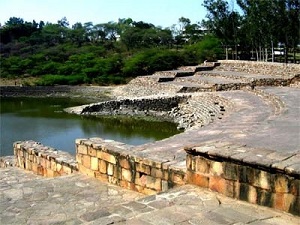 If we choose to forget the epic and go by history alone, we would say that Delhi became historically important for the first time in the 11th century as a city of the Rajputs.. The important tribes were the Tomars, the Pratiharas, and the Chauhans. It was Surajpal, a Tomar king, who built the Suraj Kund, which many of you may have visited.
If we choose to forget the epic and go by history alone, we would say that Delhi became historically important for the first time in the 11th century as a city of the Rajputs.. The important tribes were the Tomars, the Pratiharas, and the Chauhans. It was Surajpal, a Tomar king, who built the Suraj Kund, which many of you may have visited.
Over the years Delhi became the site of seven cities, most of them belonging to the Muslim period of Indian history. For some strange reason kings belonging to different dynasties (or sometimes from the same dynasty, as in the case of the Tughluqs) who came to Delhi preferred to build their own capital in a different part of the city rather than reside and renovate the existing capital. When shifting to another location they often demolished the existing buildings and used up the material for building new ones.
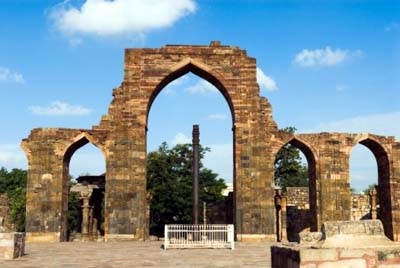 It was Anangpal, a Rajput king, who founded the first city of Delhi. Historians are not sure of the exact date when it happened.
It was Anangpal, a Rajput king, who founded the first city of Delhi. Historians are not sure of the exact date when it happened.
According to the Prithvirajaraso, a popular epic of north India, he built the Lal Kot and brought to Delhi the famous iron pillar. Many of you may have seen it in the courtyard of the Qutub Minar.
Prithviraja III, also known as Rai Pithora, renovated and extended the Lal Kot by building massive stone ramparts all around it. He also added some impressive gates. The place was then called Qila Rai Pithora (Rai Pithora’s fort). It was occupied by Qutubuddin and other rulers of the Slave Dynasty between 1206 and 1290. What now remains of the citadel include a stone wall, some gates, and parts of the ruined Lal Kot. But excavations are still going on at the site.
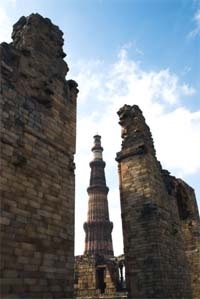 So if you visit the Qutub Minar, you could stop by and take a look at the first city of Delhi.
So if you visit the Qutub Minar, you could stop by and take a look at the first city of Delhi.
It was Alauddin Khalji who laid the foundations of Siri, the second city of Delhi in 1303. It was the first new city to be built by a Muslim king. Alauddin Khalji also dug a huge tank at Hauz Khas, originally known as Hauz- i - Alai. This reservoir was made to supply water to the people living in his new capital. Like the first, very little of the second city remains today. The only structures you will be able to locate now are stretches of a thick stone wall with “flame shaped” battlements and a few broken structures that may have been parts of a palace. These battlements were introduced for the first time by the Khaljis. You may have seen them along the Khel Gaon Marg near Shahpur Jat.
The next three cities were built by the Tughluqs between 1321 and 1414. Ghiasuddin Tughluq built Tughlaquabad, the third city. What still remain are some of the battered grey rubble walls on a desolate hill, the tomb of Ghiasuddin Tughluq, and his ruined fortress. The fortress, now the home of hundreds of monkeys, looks imposing despite its crumbling state. According to historians, the entire fortress of Tughlaqabad once stood within an artificial lake of rainwater. But there is no trace of the lake now. Many tourists take a look at the place on their way to Surajkund where the annual crafts mela is held every year.
Muhammad-bin- Tughluq built Jahanpanah, the fourth city, in 1327. It mainly consisted of a walled enclosure between Qila Rai Pithora and Siri. He wanted to connect the first and second cities of Delhi with walls so that the people living in either might feel safe and protected. There is hardly anything left of the fourth city except for Adilabad, a small fortress on the southern hill range of Tughluqabad and the Jahanpanah city forest.
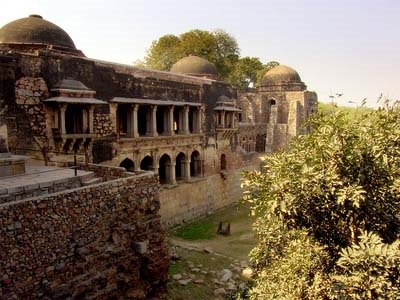 It was Firuz Shah Tughluq who built the fifth city, Firuzabad, in 1354. It covered a large area with high walls containing citadel-quadrangles, pillared halls, mosques, a pigeon tower and a baoli. The entire complex is now known as Kotla Firoz Shah. The remains of a madrassa (school) established by him and the site of the huge tank (originally built by Alauddin Khalji but restored by him) is now known as Hauz Khas and not Hauz -i- Alai. The tank is now completely dry. But there are some broken steps to remind us where it once used to be.
It was Firuz Shah Tughluq who built the fifth city, Firuzabad, in 1354. It covered a large area with high walls containing citadel-quadrangles, pillared halls, mosques, a pigeon tower and a baoli. The entire complex is now known as Kotla Firoz Shah. The remains of a madrassa (school) established by him and the site of the huge tank (originally built by Alauddin Khalji but restored by him) is now known as Hauz Khas and not Hauz -i- Alai. The tank is now completely dry. But there are some broken steps to remind us where it once used to be.
Firuz Shah enjoyed building. Some of the hunting lodges built by him are still there. Of these, the Malcha Mahal, Bhuli-Bhatiyari-ka-Mahal and Pir Ghaib lie on the Ridge. He also built many mosques. Three of the most famous ones are Kalan Masjid, Khirki Masjid and the Begampuri Masjid.
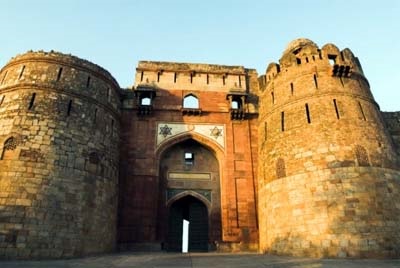 Din-e-panah, the sixth city, is better known as the Purana Qila. It was begun by the Mughal Emperor Humayun and completed by Sher Shah around 1533. It is built on a rectangular area and has three gateways, high embattled walls and bastions. The Sher Mandal, an interesting double-storeyed tower made of red stone and marble that lies within the Purana Qila used to be Humayun's library. It is said that he fell down from the steps of the library when he rushed out to answer the azaan (prayer call) and died as a result.
Din-e-panah, the sixth city, is better known as the Purana Qila. It was begun by the Mughal Emperor Humayun and completed by Sher Shah around 1533. It is built on a rectangular area and has three gateways, high embattled walls and bastions. The Sher Mandal, an interesting double-storeyed tower made of red stone and marble that lies within the Purana Qila used to be Humayun's library. It is said that he fell down from the steps of the library when he rushed out to answer the azaan (prayer call) and died as a result.
The qila also has a stately mosque. The Purana Qila stands close to the Delhi zoo and is a popular picnic spot.
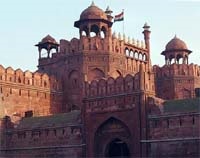 Shahjahanabad, built by Shah Jahan, the fifth Mughal Emperor, between 1638 and 1648, is the last and the grandest of the seven cities.
Shahjahanabad, built by Shah Jahan, the fifth Mughal Emperor, between 1638 and 1648, is the last and the grandest of the seven cities.
Red Fort is among the finest examples of Shahjahanabad.
Moving to Delhi
After ruling from Agra for eleven years Shah Jahan decided to move his capital to Delhi. It could be due to many reasons. Many historians think that it was because he found the streets of Agra too narrow and congested for his grand state processions. And also because he found the climate of Agra too humid and oppressive for his liking. Or it could have been because he wanted to escape from the memories of his beloved Mumtaz Mahal. But the most important reason may have been because the artist and builder in him craved to create more.
Percival Spear writes in his History of India, Volume ll –“ Shah Jahan was a man of great executive ability to which he added a love for the magnificent and a refined artistic sense, specially for architecture. He was in a special sense the architectural director of his day”. And this time he wanted to create not just a beautiful mausoleum but an entire city.
Shah Jahan decided to build his new capital at Delhi, complete with citadel and a royal residential complex. "Delhi has been the capital of Hindustan from time immemorial," he wrote in his memoir as he finalized his plan, "It shall again be the seat of the Mughal Empire. Here I shall raise a mighty fort which will be the envy of our friends and the despair of our foes.”
Din-e-panah, the sixth city of Delhi, remained a painful reminder of Humayun's tragic death. So he decided to build his new city and fortress somewhere else. But he wanted a new site that would also have a pretty landscape.
So Shah Jahan sent his Mir-i-Imarat (supervisor of buildings) to Delhi to select the site of the new city. After looking around carefully he finally chose the area around what we now know as Talkatora and Raisina Hill. But when Shah Jahan sent Ustad Hira and Ustad Hamid, two of his most expert masons, to take a look at the selected site, they turned it down at once. They told the king that the soil was too full of minerals, especially saltpeter, which would damage the buildings. They selected an open space on the right bank of the river Yamuna, close to the Salimgarh fortress that had been built by Islam Shah Suri. They said that the soil there did not have any minerals and was just right for building. The Mir-i-lmarat agreed with them. And Shah Jahan gave his final approval.
He sent architects and laborers from all over the empire. Stones for building the fort were brought from a place near Agra and carried to Delhi in enormous carts. The carts jammed the roads (something like the traffic jams you now find in Delhi!) and made things difficult for the ordinary traders who had to wait for ages to reach their ware. Sometimes it led to utter chaos and confusion and the entire neighborhood suffered as a result. Even the English factories at Agra could not move their goods to the coast! But the people had to put up with it. After all no one could fight against the Emperor's orders!
The foundation stone of the new city was laid in 1638. The construction started under the supervision of Izzat Khan, Alah Vardi Khan and Makramat Khan, with Ustad Hamid and Ustad Hira at the helm. Mir Baqr Ali Khan, one of the best known story-tellers of the time, gives us an interesting account of what happened after the work began in earnest. According to his story, both Hira and Hamid disappeared as soon as the foundation was laid. No one could find any trace of the two. The news reached the Emperor who was frantic with worry. And he was very, very angry with both of them.
In fact, he was about to order that they should be arrested and put to death immediately when they turned up as suddenly as they had disappeared. And they explained why they had run away. They said that it was because they wanted the foundation to remain open to the elements for a certain number of days. This would help the soil get properly seasoned to support an everlasting building. They were both sure that this time gap was something the supervisors would never allow. Because they were so very keen to complete the city as fast as possible! The Emperor, who had great knowledge about buildings, saw their point at once. So he forgave them for playing truant.
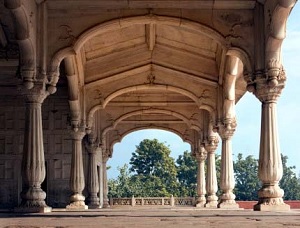 Gradually the fort began to take shape. First of all there rose the battlements, one and-a-half mile long, over sixty feet in height and octagonal in shape. Next came the royal apartments. There was the Nakkar Khana or the music room that marked the entrance to the royal enclosure. It is here that the musicians played different kinds of music (using many kinds of instruments) five times a day. A wide open space led to the Diwan-i-Am, which was the hall of public audience. The pillars and ceilings of this hall had rich ornaments of gilded stucco. It was covered with heavy brocades. Beautiful carpets covered the entire floor. There was no furniture as people sat on the carpets. The Emperor's throne was placed on a richly carved marble platform that was inlaid with semi-precious stones.
Gradually the fort began to take shape. First of all there rose the battlements, one and-a-half mile long, over sixty feet in height and octagonal in shape. Next came the royal apartments. There was the Nakkar Khana or the music room that marked the entrance to the royal enclosure. It is here that the musicians played different kinds of music (using many kinds of instruments) five times a day. A wide open space led to the Diwan-i-Am, which was the hall of public audience. The pillars and ceilings of this hall had rich ornaments of gilded stucco. It was covered with heavy brocades. Beautiful carpets covered the entire floor. There was no furniture as people sat on the carpets. The Emperor's throne was placed on a richly carved marble platform that was inlaid with semi-precious stones.
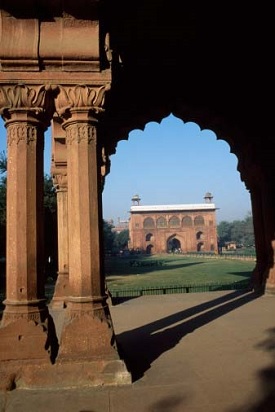 The six main palaces were built just behind the Diwan-i-Am. Only five of these palaces remain now. The first is the Mumtaz Mahal. The building is now the Delhi Museum of Archaeology, which is known for its rare Mughal exhibits. Those of you who have been to the Red Fort must have seen it already. The Rang Mahal or the palace of colors has six apartments including the glass-studded Shish Mahal. The Khas Mahal, which once consisted of the king's main living quarters, included the Tasbih Khana. This was his private room of prayers. He prayed here with the help of beads (tasbih). It also included the Khwabgah (the chamber of dreams) which was his bedroom, and the Baithak, his drawing room. The Khas Mahal has a beautiful marble lattice screen portraying the scale of justice. It was from here that the Emperor and his queens watched the elephant fights on the bank of the river. In case you are wondering which river I’m talking about, I must tell you that the river Yamuna actually flowed by the Red Fort in those days, though it changed its course subsequently and moved far away!
The six main palaces were built just behind the Diwan-i-Am. Only five of these palaces remain now. The first is the Mumtaz Mahal. The building is now the Delhi Museum of Archaeology, which is known for its rare Mughal exhibits. Those of you who have been to the Red Fort must have seen it already. The Rang Mahal or the palace of colors has six apartments including the glass-studded Shish Mahal. The Khas Mahal, which once consisted of the king's main living quarters, included the Tasbih Khana. This was his private room of prayers. He prayed here with the help of beads (tasbih). It also included the Khwabgah (the chamber of dreams) which was his bedroom, and the Baithak, his drawing room. The Khas Mahal has a beautiful marble lattice screen portraying the scale of justice. It was from here that the Emperor and his queens watched the elephant fights on the bank of the river. In case you are wondering which river I’m talking about, I must tell you that the river Yamuna actually flowed by the Red Fort in those days, though it changed its course subsequently and moved far away!
Diwan-i-Khas was the hall of special audience. The Emperor used it for meetings with specially chosen courtiers and visitors. It is here that the famous Peacock throne stood.
Then there were the Hammams or the royal baths. These are in fairly good condition even now. The floors are covered with “stone embroidery” which are really beautiful. Visitors are not allowed inside but you can peep through the window panes and catch a glimpse of the baths. Finally came the towers - Musamman Burj (the octagonal tower) and the Shah Burj (the Royal Tower) - followed by two monsoon pavilions, Sawan and Bhadon.
The fort was finally completed in 1648. Shah Jahan rewarded the masons by giving them pieces of land. You can find many of the lanes named after them. They are all around the Jama Masjid. Ustad Ahmed Lahori, another famous architect associated with the fort was given the title of Nadir-ul-Asr (wonder of the age).
Moti Masjid (The Pearl Mosque) was added later by Aurangzeb, the third son of Shah Jahan. Hira Manzil - the last addition to the fort proper - was built by Bahadur Shah Zafar, the last of the Mughal Emperors. There were other additions too. But they were less significant.
Emperor Akbar had built the Fatehpur Sikri in red stone. Shah Jahan himself had built the Taj in white marble. When building the seventh city of Delhi, he turned to the red stone once again. The lofty ramparts, the tall gateways, the music hall and Diwan-i-Am were all built with red stone. But the major royal apartments had white marble as well. The fort also included office buildings, cantonments, markets and the living quarters of the people who worked in the palace.
Continued to "A Dream Takes Shape"
Images under license with Gettyimages.com
21-Jul-2018
More by : Swapna Dutta